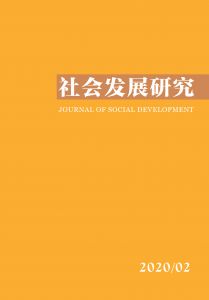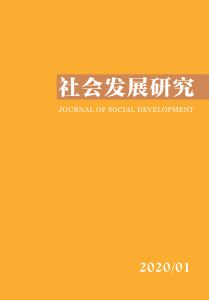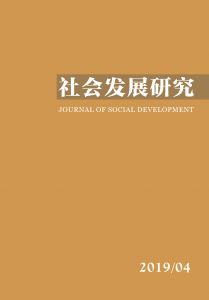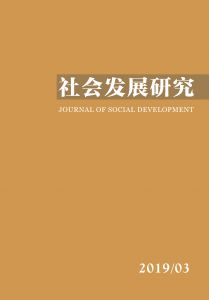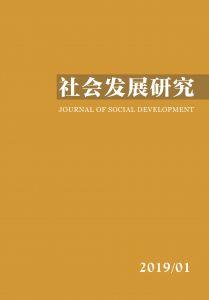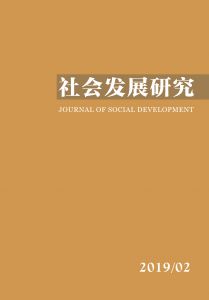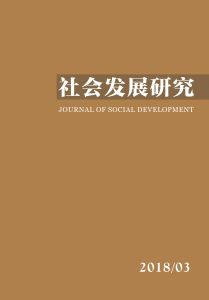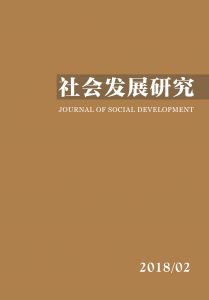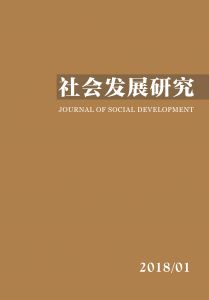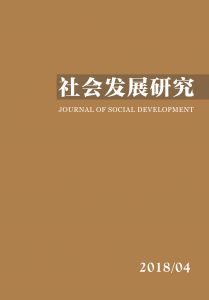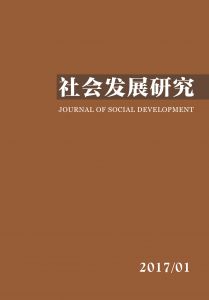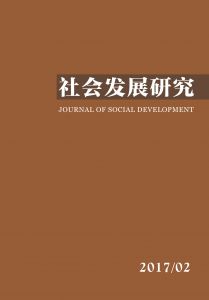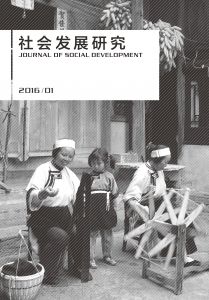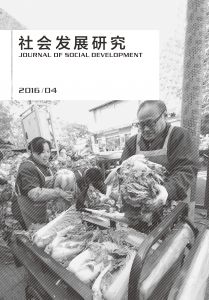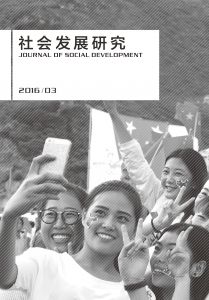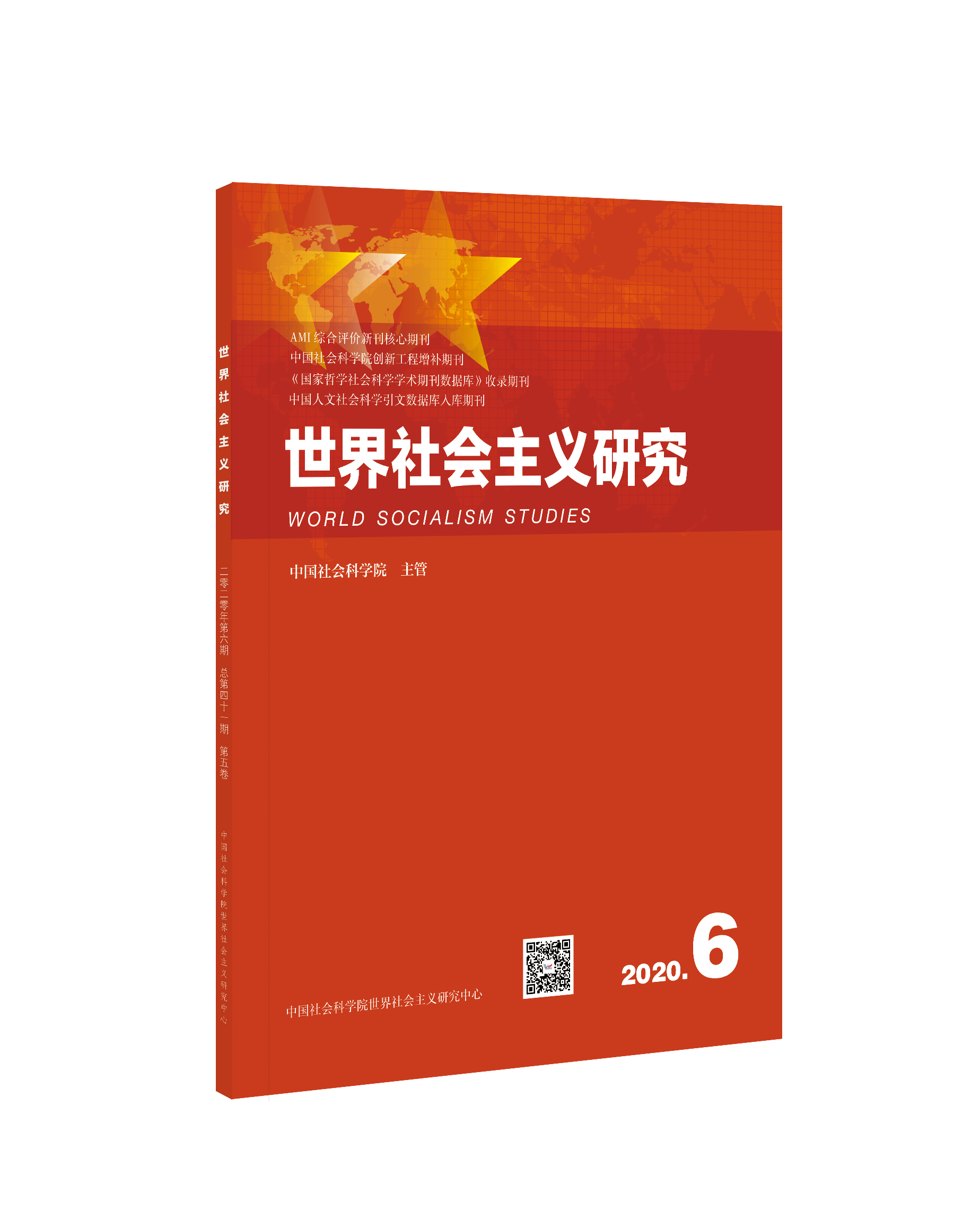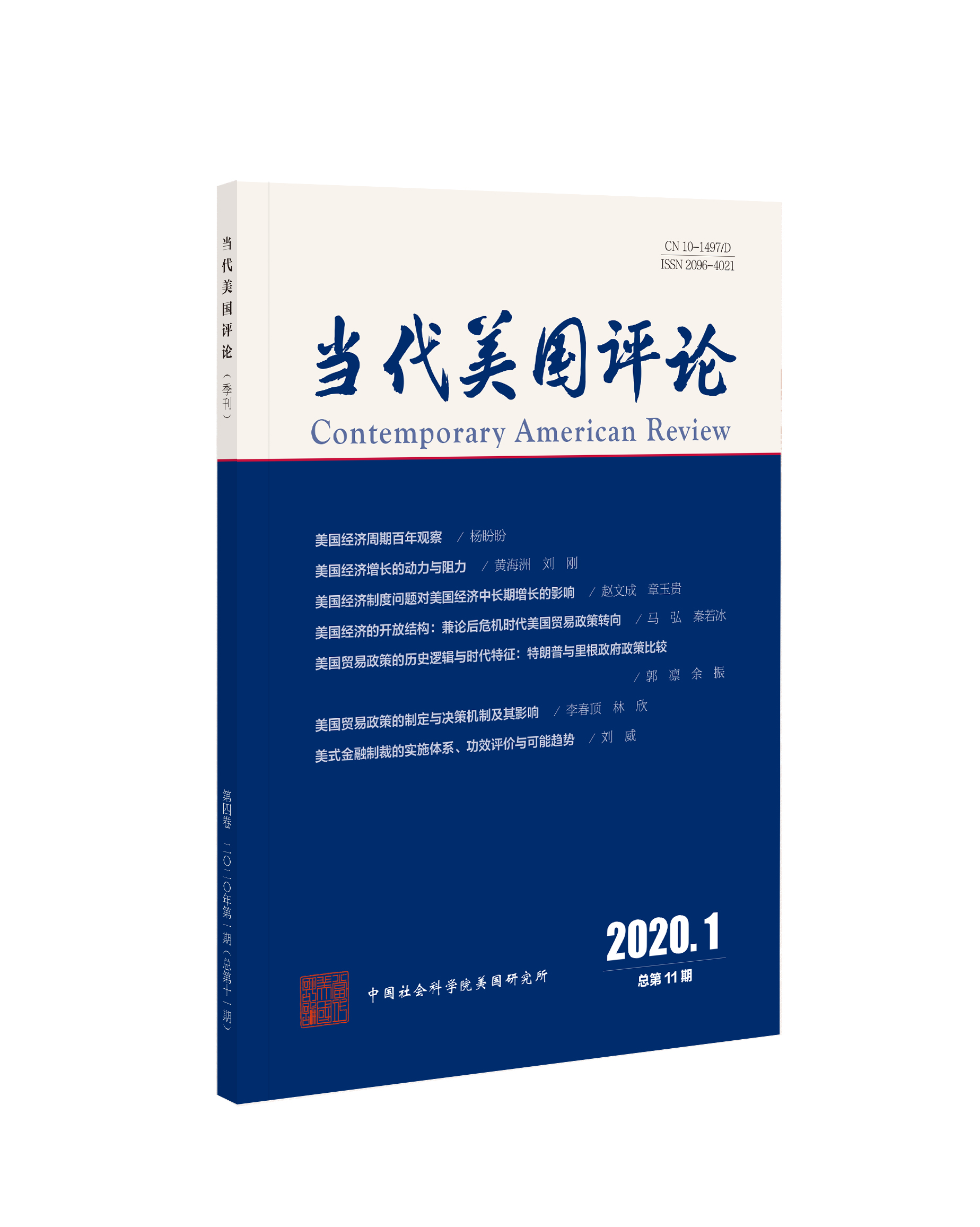最新期刊
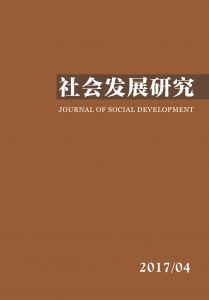
目录
过往期刊
参考文献
-
编委会
-
·论文·
-
记忆的微光的社会学分析
-
爱欲的批判与建构
-
环境污染感知与精神健康不平等
-
户籍歧视、人力资本差异与中国城镇收入不平等
-
新生代农民工文化资本对社会融合影响的实证研究
-
家庭背景、影子教育与“初升高”:理解当代中国社会教育分层的新视角
-
从聚落到泛化:论乡镇选举与村庄人一般信任模式
-
信访社工如何融入地方治理过程?
-
-
·调查报告·
-
农村女性本地就业与家庭照料的新变化及其含义
-
商品化悲剧:生态补偿与草场资源过度利用的逻辑
-
-
·马克思主义学习与研究专栏·
-
资本积累:节欲、奢侈,还是劳动?
-
-
·书评·
-
中国发展合作范式的国际共享
-
制度变迁的“理性解释”与“权力解释”
-
-
英文目录及摘要
-
《社会发展研究》2017年总目录
-
稿约
-
版权页
按年份浏览:
- 全部
- 2020
- 2019
- 2018
- 2017
- 2016
- 2015
- 2014
[1][1]阿斯曼,阿莱达,2007,《回忆有多真实?》,哈拉尔德·韦尔策编,《社会记忆:历史、回忆、传承》,季斌等译,北京:北京大学出版社。
[2][2]阿斯曼,阿莱达,2012a,《论回忆的隐喻》,冯亚琳、阿斯特莉特·埃尔主编,《文化记忆理论读本》,余传玲等译,北京:北京大学出版社。
[3][3]阿斯曼,阿莱达,2012b,《德国受害者叙事》,冯亚琳、阿斯特莉特·埃尔主编,《文化记忆理论读本》,余传玲等译,北京:北京大学出版社。
[4][4]阿斯曼,阿莱达,2012c,《回忆的真实性》,冯亚琳、阿斯特莉特·埃尔主编,《文化记忆理论读本》,余传玲等译,北京:北京大学出版社。
[5][5]阿斯曼,阿莱达,2012d,《记忆作为文化学的核心概念》,冯亚琳、阿斯特莉特·埃尔主编,《文化记忆理论读本》,余传玲等译,北京:北京大学出版社。
[6][6]阿斯曼,阿莱达,2016,《回忆空间:文化记忆的形式和变迁》,潘璐译,北京:北京大学出版社。
[7][7]阿斯曼,阿莱达、扬·阿斯曼,2012,《昨日重现——媒介与社会记忆》,冯亚琳、阿斯特莉特·埃尔主编,《文化记忆理论读本》,余传玲等译,北京:北京大学出版社。
[8][8]阿斯曼,扬,2015,《文化记忆》,北京:北京大学出版社。
[9][9]鲍德里亚,让,2013,《冷记忆》,张新木、王晶译,南京:南京大学出版社。
[10][10]德拉埃斯马,杜威,2009,《记忆的隐喻:心灵的观念史》,乔修峰译,广州:花城出版社。
[11][11]方慧容,2001,《“无事件境”与生活世界中的“真实”——西村农民土地改革时期社会生活的记忆》,杨念群主编《空间·记忆·社会转型——“新社会史”研究论文精选集》,上海:上海人民出版社。
[12][12]弗莱切,2009,《记忆的承诺:马克思、本雅明、德里达的历史与政治》,田明译,上海:华东师范大学出版社。
[13][13]哈布瓦赫,2002,《论集体记忆》,毕然、郭金华译,上海:上海世纪出版集团。
[14][14]哈布瓦赫,2012,《集体记忆与历史记忆》,冯亚琳、阿斯特莉特·埃尔主编,《文化记忆理论读本》,余传玲等译,北京:北京大学出版社。
[15][15]康纳顿,保罗,2000,《社会如何记忆》,纳日碧力戈译,上海:上海人民出版社。
[16][16]科赫,格特鲁德,2007,《感情或效果:图片有哪些文字所没有的东西?》,哈拉尔德·韦尔策编,《社会记忆:历史、回忆、传承》,季斌等译,北京:北京大学出版社。
[17][17]李猛,2013,《探寻他们是谁》,吴飞,《麦芒上的圣言:一个乡村天主教群体中的信仰与生活》,北京:宗教文化出版社。
[18][18]刘亚秋,2010,《从集体记忆到个体记忆:对社会记忆研究的一个反思》,《社会》第5期。
[19][19]玛格利特,阿维夏伊,2015,《记忆的伦理》,贺海仁译,北京:清华大学出版社。
[20][20]诺拉,皮埃尔,2015,《记忆与历史之间:场所问题》,皮埃尔·诺拉主编,《记忆之场:法国国民意识的文化社会史》,黄艳红等译,南京:南京大学出版社。
[21][21]普鲁斯特,马塞尔,2012,《追忆似水年华》,李恒基等译,南京:译林出版社。
[22][22]瑞格比,安德鲁,2003,《暴力之后的正义与和解》,刘成译,南京:译林出版社。
[23][23]史景迁,2005,《王氏之死:大历史背后的小人物命运》,李璧玉译,上海:上海远东出版社。
[24][24]舒衡哲,1995,《第二次世界大战:在博物馆的光照之外》,《东方》第5期。
[25][25]王明珂,2001,《历史事实、历史记忆与历史心性》,《历史研究》第5期。
[26][26]萧阿勤,1997,《集体记忆理论的检讨:解剖者、拯救者与一种民主观点》,《思与言》第35卷第1期。
[27][27]周永康、李甜甜,2015,《记忆的微光:社会记忆中的个体记忆——对阎连科小说〈我与父辈〉的社会学解读》,《名作欣赏》第18期。
[28][28]Assmann,Aleida 2011,Cultural Memory and Western Civilization:Functions,Media,Archives ,Cambridge:Cambridge University Press.
[29][29]Assmann,Aleida 2012,“To Remember or to Forget:Which Way Out of a Shared History of Violence?” In Aleida Assmann & linda Shortt (eds.),Memory and Political Change ,Houndmills:Palgrave macmillan.
[30][30]Kansteiner,Wulf 2002,“Finding Meaning in Memory:A Methodological Critique of Collective Memory Studies”,History and Theory ,41(2).
[31][31]Karkowska,Marta 2013,“On the Usefulness of Aleida and Jan Assmann’s Concept of Cultural Memory for Studying Local Communities in Contemporary Poland—the Case of Olsztyn”,Polish Sociological Review ,no.183.
[32][32]Olick,Jeffrey K.1999,“Collective Memory:The Two Cultures”,Sociological Theory ,17(3).
[33][33]艾布拉姆森,1987,《弗洛伊德的爱欲论:自由及其限度》,陆杰荣、顾春明、都本伟、王本浩译,沈阳:辽宁大学出版社。
[34][34]柏拉图,2013,《会饮篇》,王太庆译,北京:商务印书馆。
[35][35]芬博格,2010,《海德格尔与马尔库塞:历史的灾难与救赎》,文成伟译,上海:上海社会科学院出版社。
[36][36]弗洛伊德,2003,《一种幻想的未来文明及其不满》,严志军、张沫译,石家庄:河北教育出版社。
[37][37]弗洛伊德,2012,《自我与本我》,林尘、张唤民、陈伟奇译,上海:上海译文出版社。
[38][38]霍克海默、阿多诺,2014,《启蒙辩证法:哲学断片》,渠敬东、曹卫东译,上海:上海人民出版社。
[39][39]杰伊,1996,《法兰克福学派史》,单世联译,广州:广东人民出版社。
[40][40]马尔库塞,1983a,《历史唯物主义的基础》,复旦大学哲学系现代西方哲学研究室编译《西方学者论〈一八八四年经济学—哲学手稿〉》,上海:复旦大学出版社。
[41][41]马尔库塞,1983b,《自然与革命》,复旦大学哲学系现代西方哲学研究室编译《西方学者论〈一八八四年经济学—哲学手稿〉》,上海:复旦大学出版社。
[42][42]马尔库塞,1989,《现代文明与人的困境——马尔库塞文集》,李小兵等译,上海:上海三联书店。
[43][43]施特劳斯,2012,《论柏拉图的〈会饮〉》,邱立波译,北京:华夏出版社。
[44][44]魏格豪斯,2010,《法兰克福学派:历史、理论及政治影响》,孟登迎、赵文、刘凯译,上海:上海人民书店。
[45][45]Kellner,Douglas 1984,Herbert Marcuse and the Crisis of Marxism . Los Angeles:University of California Press.
[46][46]Marcuse,Herbert 1955,Reason and Revolution:Hegel and the Rise of Social Theory . London:Routledge & Kegan Paul Ltd.
[47][47]Marcuse,Herbert 1969,An Essay on Liberation . Boston:Beacon Press.
[48][48]Marcuse,Herbert 1974,Eros and Civilization:A Philosophical Inquiry into Freud . Boston:Beacon Press.
[49][49]Marcuse,Herbert 2007,One-Dimensional Man:Studies in the Ideology of Advanced Industrial Society . London:Routledge Classics.
[50][50]Marcuse,Herbert & Karl Popper 1985,Revolution or Reform?A Confrontation between Herbert Marcuse and Karl Popper ,Ferguson (ed.). Trans by Aylward & Ferguson. New York:New University Press,Inc.
[51][51]Rickert,John 1986,“The Fromm-Marcuse Debate Revisited”,Theory and Society 15(3).
[52][52]陈阿江、程鹏立,2011,《村民是如何化解环境健康风险的?》,《南京农业大学学报》(社会科学版)第2期。
[53][53]洪大用、肖晨阳,2007,《环境关心的性别差异分析》,《社会学研究》第2期。
[54][54]洪大用、卢春天,2011,《公众环境关心的多层分析——基于中国CGSS 2003的数据应用》,《社会学研究》第6期。
[55][55]洪大用、范叶超、叶佩繁,2016,《地位差异、适应性与绩效期待——空气污染诱致的居民迁出意向分异研究》,《社会学研究》第3期。
[56][56]黄永明、何凌云,2013,《城市化、环境污染与居民主观幸福感——来自中国的经验证据》,《中国软科学》第12期。
[57][57]梁樱,2013,《心理健康的社会学视角——心理健康社会学综述》,《社会学研究》第2期。
[58][58]王甫勤,2017,《代际社会流动与精神健康》,《社会发展研究》第1期。
[59][59]杨继东、章逸然,2014,《空气污染的定价:基于幸福感数据的分析》,《世界经济》第12期。
[60][60]袁浩,2011,《经济社会地位、年龄与心理健康:一项基于上海的实证研究》(英文),《社会》第1期。
[61][61]张晓,2014,《中国水污染趋势与治理制度》,《中国软科学》第10期。
[62][62]Aneshensel,C.S.,C.M.Rutter,& P.A.Lachenbruch,1991,“Social Structure,Stress,and Mental Health:Competing Conceptual and Analytic Models.” American sociological review 56 (2).
[63][63]Aneshensel,C.S.1992,“Social stress:Theory and Research.” Annual Review of Sociology 18 (1).
[64][64]Aneshensel,C.S. & Jo C.Phelan.1999,“The Sociology of Mental Health:Surveying the Field”,In Aneshensel,C.S. and Jo C.Phelan (eds.),Handbook of the Sociology of Mental Health . New York:Kluwer Academic Press.
[65][65]Aneshensel,C.S.2009a,“Toward Explaining Mental Health.” Journal of Health and Social Behavior 50 (4).
[66][66]Aneshensel,C.S.2009b. “Neighborhood as a Social Context of the Stress Process”,In Avison,W.R.et al.(eds.),Advances in the Conceptualization of the Stress Process:Essays in Honor of Leonard I.Pearlin ,Springer Science+Business Media,LLC.
[67][67]Bolin,B.2007,“Race,Class,Ethnicity,and Disaster Vulnerability”,In Havidán Rodríguez,Enrico L.Quarantelli & Russell R.Dynes(eds.),Handbook of Disaster Research . New York:Springer.
[68][68]Brulle,R.J. & D.N.Pellow,2006,“Environmental Justice:Human Health and Environmental Inequalities.” Annual Review of Public Health 27 (1).
[69][69]Bullard,R.D.2000,Dumping in Dixie:Race,Class,and Environmental Quality (Vol.3),Boulder,CO:Westview Press.
[70][70]Cutter,S.,B.J.Boruff,& W.L.Shirley,2006,“Social Vulnerability to Environmental Hazards.” Hazards,Vulnerability,and Environmental Justice 84 (2).
[71][71]Dalgard,O.S. & K.Tambs.1997,“Urban Environment and Mental Health:A Longitudinal Study.” The British Journal of Psychiatry 171(6).
[72][72]Diener,E.L.,R.J.Larsen,S.Levine & R.A.Emmons.1985. “Intensity and frequency:Dimensions underlying positive and negative affect.” Journal of personality and social psychology 48(5).
[73][73]Downey,L.1998,“Environmental Injustice:Is Race or Income A Better Predictor?” Social Science Quarterly 79(4).
[74][74]Evans,G.W. & Cohen.Sheldon,1987,“Environmental Stress”,In Stokols,Daniel & Irwin,Altman (eds.),Handbook of Environmental Psychology . John Wiley & Sons.
[75][75]Evans,G.W.,D.C.Steven & D.F.Shearer.1988,“Psychological Reactions to Air Pollution.” Environmental Research 45 (1).
[76][76]Evans,G.W. & E.Kantrowitz.2002,“Socioeconomic Status and Health:The Potential Role of Environmental Risk Exposure.” Annual Review of Public Health 23 (1).
[77][77]Ferrer-i-Carbonell,Ada & John M.Gowdy.2007,“Environmental Degradation and Happiness.” Ecological Economics 60 (3).
[78][78]Folkman,S. & R.S.Lazarus.1980,“An Analysis of Coping in a Middle-Aged Community Sample.” Journal of Health and Social Behavior 21(3).
[79][79]Hamilton,V.L.,C.L.Broman,W.S.Hoffman,& D.S.Renner,1990,“Hard Times and Vulnerable People:Initial Effects of Plant Closing on Autoworkers’ Mental Health.” Journal of Health and Social Behavior 31 (2).
[80][80]Havard,S.,B.J.Reich,K.Bean,& B.Chaix,2011,“Social Inequalities in Residential Exposure to Road Traffic Noise:An Environmental Justice Analysis Based on the Record Cohort Study.” Occupational & Environmental Medicine 68 (5).
[81][81]Hird,J.A. & M.Reese,1998,“The Distribution of Environmental Quality:An Empirical Analysis.” Social Science Quarterly,79 (4) .
[82][82]Kessler,R.C.1979,“A Strategy for Studying Differential Vulnerability to the Psychological Consequences of Stress.” Journal of Health and Social Behavior 20 (2).
[83][83]Kessler,R.C. & P.D.Cleary,1980,“Social Class and Psychological Distress.” American Sociological Review 45 (3) .
[84][84]Kessler,R.C. & H.W.Neighbors,1986,“A New Perspective on the Relationships among Race,Social class,and Psychological distress.” Journal of Health and Social Behavior 27 (2).
[85][85]Kessler,R.C.,K.D.Mickelson & D.R.Williams.1999,“The Prevalence,Distribution,and Mental Health Correlates of Perceived Discrimination in the United States.” Journal of Health and Social Behavior 40 (3).
[86][86]Kohlhuber,M.,A.Mielck,S.K.Weiland & G.Bolte.2006,“Social Inequality in Perceived Environmental Exposure in Relation to Housing Conditions in Germany.” Environmental Research 101 (2).
[87][87]Lazarus,R.S. & S.Folkman,1984,Stress,Appraisal,and Coping . Springer Publishing Company.
[88][88]Laktin,C.A.,& A.D.Curry.2003,“Stressful Neighborhood and Depression:A Prospective Study of the Impact of Neighborhood Disorder.” Journal of Health and Social Behavior 44 (1).
[89][89]Lercher,P.,G.W.Evans,M.Meis & W.W.Kofler.2002. “Ambient Neighborhood Noise and Children’s Mental Health.” Occupational & Environmental Medicine 59(6).
[90][90]Leventhal,T. & J.Brooks-Gunn.2003,“Moving to Opportunity:An Experimental Study of Neighborhood Effects on Mental Health.” American Journal of Public Health ,93(9).
[91][91]Link B.,M.C.Lennon & B.P.Dohrenwend.1993,“Socioeconomic Status and Depression:the Role of Occupations Involving Direction,Control,and Planning.” American Journal of Sociology 98 (6).
[92][92]Lim,Youn-Hee,Kim Ho,Kim JinHee,Bae Sanghyuk,Park Hye Yin & Hong Yun-Chul.2012,“Air Pollution and Symptoms of Depression in Elderly Adults.” Environmental Health Perspectives .120 (7).
[93][93]Lorant,V.,D.Deliège,W.Eaton,A.Robert,P.Philippot,& M.Ansseau,2003,“Socioeconomic Inequalities in Depression:A Meta-analysis.” American journal of epidemiology 157(2).
[94][94]MacKerron,G. & S.Mourato.2008,“Life Satisfaction and Air Quality in London.” Ecological Economics .68 (5).
[95][95]McLeod,J.D. & R.C.Kessler.1990,“Socioeconomic Status Differences in Vulnerability to Undesirable Life Events.” Journal of Health and Social Behavior 31 (2).
[96][96]Meyer IIan H.,S.Schwartz,& D.M.Frost.2008,“Social Patterning of Stress and Coping:Disadvantaged Social Statuses Confer More Stress and Fewer Coping Resources?” Social Science and Medicine 67 (3).
[97][97]Mirowsky,J.,& C.E.Ross.2003,Social Causes of Psychological Distress . New York:Aldine de Gruyter.
[98][98]Mirowsky,J.2007. “The Distribution’s Tail:A Comment.” Health:An Interdisciplinary Journal for the Social Study of Health,Illness,and Medicine 11 (3).
[99][99]Mohai,P. & B.Bryant,1998,“Is There A ‘Race’ Effect on Concern for Environmental Quality?” Public Opinion Quarterly 62 (4) .
[100][100]Mohai,P. & R.Saha,2006,“Reassessing Racial and Socioeconomic Disparities in Environmental Research.” Demography 43(2).
[101][101]Patel,V. & A.Kleinman.2003,“Poverty and Common Mental Disorders in Developing Countries.” Bulletin of the World Health Organization 81(8).
[102][102]Pearlin,L.I.,M.A.Lieberman,E.G.Menaghan,& J.T.Mullan.1981,“The Stress Process.” Journal of Health and Social Behavior 22 (4).
[103][103]Pearlin L.I.1999,“The Stress Process Revisited:Reflections on Concepts and Their Interrelationships”,In Aneshensel,C.S. & Jo C.Phelan (eds.),Handbook of the Sociology of Mental Health . New York:Kluwer Academic Press.
[104][104]Preacher,K.J.,D.D.Rucker & A.F.Hayes.2007,“Addressing Moderated Mediation Hypotheses:Theory,Methods,and Prescriptions.” Multivariate behavioral research 42(1).
[105][105]Rosenfield,S.2012,“Triple Jeopardy?Mental Health at the Intersection of Gender,Race,and Class.” Social Science and Medicine 74 (11).
[106][106]Taylor-Clark,K.,H.Koh & K.Viswanath.2007,“Perceptions of Environmental Health Risks and Communication Barriers Among Low-SEP and Racial/ethnic Minority Communities.” Journal of Health Care for the Poor & Underserved 18(4 Suppl).
[107][107]Thoits,P.A.1987,“Gender and Marital Status Differences in Control and Distress:Common Stress Versus Unique Stress Explanations.” Journal of Health and Social Behavior 28(1).
[108][108]Thoits,P.A.1995,“Stress,Coping,and Social Support:Where Are We?What Next?” Journal of Health and Social Behavior 9(1).
[109][109]Tierney K.J.2007,“From the Margins to the Mainstream?Disaster Research at the Crossroads.” Annual Review of Sociology 33(1).
[110][110]Turner,R.J. & D.A.Lloyd.1999,“The Stress Process and the Social Distribution of Depression.” Journal of Health and Social Behavior 40 (4).
[111][111]Turner,R.J. & W.R.Avison.2003,“Status Variations in Stress Exposure:Implications for the Interpretation of Research on Race,Socioeconomic Status,and Gender.” Journal of Health and Social Behavior 44 (4).
[112][112]Ulbrich,P.,G.Warheit & R.Zimmerman.1989,“Race,Socioeconomic Status,and Psychological Distress:An Examination of Differential Vulnerability.” Journal of Health and Social Behavior 30(1).
[113][113]Watson D.,L.A.Clark & A.Tellegen.1988,“Development and Validation of Brief Measures of Positive and Negative Affect:The PANAS Scales.” Journal of Personality and Social Psychology 54 (6).
[114][114]Weichselgartner,J.2001,“Disaster Mitigation:the Concept of Vulnerability Revisited.” Disaster Prevention and Management:An International Journal 10 (2).
[115][115]Welsch,Heinz.2005,“Environment and Happiness:Valuation of Air Pollution Using Life Satisfaction Data.” Ecological Economics 58 (4).
[116][116]Wheaton,Blair.1994,“Sampling the Stress Universe”,In Avison W.R. & I.H.Gotlib (eds.),Stress and Mental Health . NY:Plenum.
[117][117]Wheaton,Blair2001,“The Role of Sociology in the Study of Mental Health and the Role of Mental Health in the Study of Sociology.” Journal of Health and Social Behavior 42 (3).
[118][118]Yu,Y. & D.R.Williams.1999,“Socioeconomic Status and Mental Health”,In Aneshensel,C.S. and Jo C.Phelan (eds.),Handbook of the Sociology of Mental Health . New York:Kluwer Academic Press.
[119][119]边燕杰、李路路、李煜、郝大海,2006,《结构壁垒、体制转型与地位资源含量》,《中国社会科学》第5期。
[120][120]陈云松、张翼,2015,《城镇化的不平等效应与社会融合》,《中国社会科学》第6期。
[121][121]邓曲恒,2007,《城镇居民与流动人口的收入差异——基于Oaxaca-Blinder和Quantile方法的分解》,《中国人口科学》第2期。
[122][122]蔡昉,1998,《二元劳动力市场条件下的就业体制转换》,《中国社会科学》第2期.
[123][123]冯虹、杨桂宏,2013,《户籍制度与农民工就业歧视辨析》,《人口与经济》第2期。
[124][124]李芹、刘万顺,2009,《农民工就业歧视的制度排斥及非制度排斥》,《城市问题》第2期。
[125][125]李骏,2016,《中国城镇劳动力市场分割:一个整合与比较分析》,《江海学刊》第3期。
[126][126]钱文荣、卢海阳,2012,《农民工人力资本与工资关系的性别差异及户籍地差异》,《中国农村经济》第8期。
[127][127]王甫勤,2010,《人力资本、劳动力市场分割与收入分配》,《社会》第1期。
[128][128]王美艳,2005,《城市劳动力市场上的就业机会与工资差异——外来劳动力就业与报酬研究》,《中国社会科学》第5期。
[129][129]王天夫、崔晓雄,2010,《行业是如何影响收入的——基于多层线性模型的分析》,《中国社会科学》第5期。
[130][130]吴晓刚、张卓妮,2014,《户口、职业隔离与中国城镇的收入不平等》,《中国社会科学》第6期。
[131][131]吴愈晓,2012,《中国城乡居民教育获得的性别差异研究》,《社会》第4期。
[132][132]谢桂华,2007,《农民工与城市劳动力市场》,《社会学研究》第5期。
[133][133]余向华、陈雪娟,2012,《中国劳动力市场的户籍分割效应及其变迁——工资差异与机会差异双重视角下的实证研究》,《经济研究》第12期。
[134][134]岳希明、李实、史泰丽,2010,《垄断行业高收入问题探讨》,《中国社会科学》第3期。
[135][135]周其仁,1997,《机会与能力:中国农村劳动力的就业和流动》,《管理世界》第5期。
[136][136]赵耀辉,1997,《中国农村劳动力流动及教育在其中的作用:以四川省为基础的研究》,《经济研究》第2期。
[137][137]赵毅涛,2006,《中国农村的教育收益率研究》,《中国社会科学》第3期。
[138][138]张永丽、黄祖辉,2008,《中国农村劳动力流动研究述评》,《中国农村观察》第1期。
[139][139]张智勇,2005,《户籍制度:农民工就业歧视形成之根源》,《农村经济》第4期。
[140][140]张慧,2006,《农民工就业歧视问题分析》,《上海经济研究》第10期。
[141][141]章莉、李实、William A.DarityJr.、Rhonda Vonshay Sharpe,2014,《中国劳动力市场上工资收入的户籍歧视》,《管理世界》第11期。
[142][142]Anderson,Kathryn H.,John S.Butler & Frank A.Sloan.1987. “Labor Market Segmentation:A Cluster Analysis of Job Groupings and Barriers to Entry.” Southern Economic Journal 53(3):571-590.
[143][143]Baron,James N. & William T.Bielby.1984. “The Organization of Work in a Segmented Economy.” American Sociological Review 49(4):454-473.
[144][144]Beck,E.M.,Patrick M.Horan & Charles M.Tolbert.1978. “Stratification in a Dual Economy:A Sectoral Model of Earnings Determination.” American Sociological Review 43 (5):704-720.
[145][145]Blossfeld,Hans-Peter & Karl U.Mayer.1988. “Labor Market Segmentation in the Federal Republic of Germany:An Empirical Study of Segmentation Theories from a Life Course Perspective.” European Sociological Review 4 (2):123-140.
[146][146]Boston,Thomas D.1990. “Segmented Labor Markets:New Evidence from a Study of Four Race-Gender Groups.” Industrial & Labor Relations Review 44(1):99-115.
[147][147]Cohen,Philip N. & Matt L.Huffman.2003. “Individuals,Jobs,and Labor Markets:The Devaluation of Women’s Work.” American Sociological Review 68(3):1-18.
[148][148]Dickens,William T. & Kevin Lang.1985. “A Test of Dual Labor Market Theory.” The American Economic Review 75(4):792-805.
[149][149]Doeringer,Peter & Michael J.Piore.1971. Internal Labor Markets & Manpower Analysis . Lexington,MA.:D.C.Heath.
[150][150]Drago,Robert.1995. “Divide and Conquer in Australia:A Study of Labor Segmentation.” Review of Radical Political Economics 27(1):25-70.
[151][151]Fan,C.Cindy.2002. “The Elite,the Natives,and the Outsiders:Migration and Labor Market Segmentation in Urban China.” Annals of the Association of American Geographers 92(1):103-124.
[152][152]Hodson,Randy & Robert L.Kaufman.1982. “Economic Dualism:A Critical Review.” American Sociological Review 47(6):727-739.
[153][153]Hudson,Kenneth.2007. “The New Labor Market Segmentation:Labor Market Dualism in the New Economy.” Social Science Research 36(1):286-312.
[154][154]Jann,Ben.2008. “The Blinder-Oaxaca Decomposition for Linear Regression Models.” Stata Journal 8(4):453-479.
[155][155]Karlson,Kristian Bernt & Anders Holm.2011. “Decomposing primary and secondary effects:A new decomposition method.” Research in Social Stratification and Mobility 29(2):221-237.
[156][156]Karlson,Kristian Bernt,Anders Holm & Richard Breen.2012. “Comparing Regression Coefficients Between Same-sample Nested Models Using Logit and Probit A New Method.” Sociological Methodology 42(1):286-313.
[157][157]Lin,Nan & Yanjie Bian.1991. “Getting Ahead in Urban China.” American Journal of Sociology 97(3):657-688.
[158][158]McCutcheon,Allan L 1987,Latent Class Analysis . Newbury Park,CA:Sage Publications.
[159][159]Meng,Xin & Junsen Zhang.2001. “The Two-Tier Labor Market in Urban China:Occupational Segregation and Wage Differentials between Urban Residents and Rural Migrants in Shanghai.” Journal of Comparative Economic 29(3):485-504.
[160][160]Petersen,Trond & Laurie A.Morgan.1995. “Separate and Unequal:Occupation-Establishment Sex Segregation and the Gender Wage Gap.” American Journal of Sociology 101(2):329-365.
[161][161]Rodriguez,Santiago Budria & Pedro Telhado Pereira.2007. “The Wage Effects of Training in Portugal:Differences across Skill Groups,Genders,Sectors and Training Types.” Applied Economics 39(6):787-807.
[162][162]Stolzenberg,Ross M.1975 “Occupations,Labor Markets and the Process of Wage Attainment”,American Sociological Review 40(5):645-665.
[163][163]Winship,Christopher & Rorbet D.Mare.1984. “Regression models with ordinal variables.” American Sociological Review 49(4):512-525.
[164][164]Zucker,Lynne G. & Carolyn Rosenstein.1981. “Taxonomies of Institutional Structure:Dual Economy Reconsidered.” American Sociological Review 46 (6):869-884.
[165][165]布迪厄,1997,《文化资本与社会炼金术:布尔迪厄访谈录》.包亚明译,上海:上海人民出版社。
[166][166]陈丰,2007,《当前农民工市民化的制度缺失与归位》,《南京师大学报》(社会科学版)第1期。
[167][167]管健,2006,《身份污名的建构与社会表征——以天津N辖域的农民工为例》,《青年研究》第3期。
[168][168]郭元凯、胡晓江,2015,《职业教育对新生代农民工社会能力影响研究——基于全国5省市的实证分析》,《职业技术教育》第25期。
[169][169]赖晓飞,2009,《文化资本与农村流动人口的城市融入——基于厦门市Z工厂的实证研究》,《南京农业大学学报》(社会科学版)第4期。
[170][170]李培林、田丰,2012,《中国农民工社会融入的代际比较》,《社会》第5期。
[171][171]李为君,2012,《文化资本视角下的农民工职业地位研究》,《山东省农业管理干部学院学报》第9期。
[172][172]李煜,2001,《文化资本、文化多样性与社会网络资本》,《社会学研究》第4期。
[173][173]李振刚,2015,《文化分析视角的新生代农民工社会融合研究》,《中国青年研究》第12期。
[174][174]林宇,2011,《家庭文化资与农民工子女成就动机内驱力》,厦门:厦门大学出版社。
[175][175]刘辉武,2007,《文化资本与农民工的城市融入》,《农村经济》第1期。
[176][176]刘娜,2015,《融入新阶层还是适应新生活:对农村流动人口社会融合的新探索》,《北京社会科学》第7期。
[177][177]刘水芬、张梅龙,2009,《农民工法律知识缺乏对农村劳动力转移的影响》,《商业时代》第1期。
[178][178]秦广强,2014,《进京农民工的语言能力与城市融入——基于适应性区群抽样数据的分析》,《语言文字应用》第3期。
[179][179]王春光,2001,《新生代农村流动人口的社会认同与城乡融合的关系》,《社会学研究》第3期。
[180][180]王春光,2011,《中国社会政策调整与农民工城市融入》,《探索与争鸣》第5期。
[181][181]王娇娜,2016,《教育类型、职业生涯与劳动力市场回报》,《社会发展研究》第1期。
[182][182]王小红,2008,《文化资本与农村转移人员的社会地位》,《北京工业大学学报》(社会科学版)第6期。
[183][183]魏万青、白芸,2016,《高职教育能提升劳动力市场优势吗——基于CFPS2010的比较研究》,《社会发展研究》,第4期。
[184][184]谢桂华,2012,《中国流动人口的人力资本回报与社会融合》,《中国社会科学》第4期。
[185][185]杨菊华,2009,《从隔离、选择融入到融合:流动人口社会融入问题的理论思考》,《人口研究》第1期。
[186][186]杨菊华,2015,《中国流动人口的社会融入研究》,《中国社会科学》第2期。
[187][187]俞国良、金光,1992,《自卑与超越:农村籍青年知识分子的成才之路》,《青年研究》第12期。
[188][188]悦中山、李树茁、靳小怡,2011,《从“先赋”到“后致”:农民工的社会网络与社会融合》,《社会》第6期。
[189][189]悦中山,李树茁,费尔德曼,2012,《农民工社会融合的概念建构与实证分析》,《当代经济科学》第1期。
[190][190]赵芳、黄润龙,2008,《文化资本与农民工的城市融入》,《法制与社会》第13期。
[191][191]张军、王邦虎,2013,《新生代农民工城市融入的文化资本支持》,《安徽农业大学学报》(社会科学版)第2期。
[192][192]张悦玲、高彦,2012,《基于人力资本培训的农民工市民化问题研究》,《农村经济与科技》第2期。
[193][193]郑祖强,2014,《文化资本视角下农民工群体社会地位获得研究》,广西大学硕士论文。
[194][194]周皓,2012,《流动人口社会融合的测量及理论思考》,《人口研究》第3期。
[195][195]朱虹,2003,《收割城市的女孩:文化资本与打工妹城市生活世界的建构》,哈尔滨:黑龙江人民出版社。
[196][196]朱虹,2004,《打工妹的城市社会化——一项关于农民工城市适应的经验研究》,《南京大学学报》(哲学.人文科学.社会科学版)第6期。
[197][197]朱力,2002,《论农民工阶层的城市适应》,《江海学刊》第6期。
[198][198]朱伟珏,2005,《“资本”的一种非经济学解读——布迪厄“文化资本”概念》,《社会科学》第6期。
[199][199]朱伟珏,2006,《超越社会决定论——布迪厄“文化资本”概念再考》,《南京社会科学》第3期。
[200][200]Ager,A. & Strang,A.2008,“Understanding Integration:A Conceptual Framework.” Journal of Refugee Studies ,21(2).
[201][201]Lo MCM.2015,“Conceptualizing ‘Unrecognized Cultural Currency’:Bourdieu and Everyday Resistance among the Dominated”. Theory & Society ,44(2).
[202][202]Penninx R.2006,“Integration processes of migrants.Research findings and policy lessons”. Medical Device Technology ,2(1).
[203][203]Warner & Srole.1945,The social systems of American ethnic groups ,London:Yale University Press.
[204][204]陈全功,2009,《课外补习、贫富差距的映像与代际变化》,《西北人口》第5期。
[205][205]楚红丽,2008,《公共教育中的不公平问题——义务教育阶段不同收入家庭的教育支出负担率分析》,《教育学术月刊》第1期。
[206][206]楚红丽,2009,《我国中小学生课外补习家庭之背景特征及个人因素》,《教育学术月刊》第12期。
[207][207]丁小浩、薛海平,2005,《我国城镇居民家庭义务教育支出差异性研究》,《教育与经济》第4期。
[208][208]范晓慧,2008,《“影子教育”的思考:多种视角》,《清华大学教育研究》第6期。
[209][209]方长春、风笑天,2005,《阶层差异与教育获得——一项关于教育分流的实证研究》,《清华大学教育研究》第5期。
[210][210]方长春、风笑天,2008,《家庭背景与学业成就——义务教育中的阶层差异研究》,《浙江社会科学》,第8期。
[211][211]胡咏梅、范文凤、丁维莉,2015,《影子教育是否扩大教育结果的不平等——基于PISA2012上海数据的经验研究》,《北京大学教育评论》第3期。
[212][212]黄毅志、陈俊玮,2008,《学科补习、成绩成现与升学结果——以学测成绩与上公立大学为例》,《教育研究集刊》第1期。
[213][213]李春玲,2010,《高等教育扩张与教育机会不平等——高校扩招的平等化效应考查》,《社会学研究》第3期。
[214][214]李春玲,2014,《教育不平等的年代变化趋势(1940—2010)——对城乡教育机会不平等的再考察》,《社会学研究》第2期。
[215][215]李佳丽、胡咏梅、范文凤,2016,《家庭背景、影子教育和学生学业成绩——基于Wisconsin模型的经验研究》,《教育经济评论》第1期。
[216][216]李习凡、何雨,2011,《阶层优势的代际复制:精英中学选拔机制的社会学分析——以南京F学校为例》,《学海》第5期。
[217][217]李忠路、邱泽奇,2016,《家庭背景如何影响儿童学业成就?——义务教育阶段家庭社会经济地位影响差异分析》,《社会学研究》第4期。
[218][218]刘精明,2006,《高等教育扩展与入学机会差异:1978—2003》,《社会》第3期。
[219][219]庞圣民,2016,《市场转型、教育分流与中国城乡高等教育机会不平等(1997—2008)》兼论重点中学制度是否应该为城乡高等教育机会不平等买单》,《社会》第5期。
[220][220]钱国英、唐丽静,2009,《城市义务教育阶段学生参加课外补习机率的影响因素分析——基于武汉、深圳的调查》,《教育财会研究》第3期。
[221][221]王威海、顾源,2012,《中国城乡居民的中学教育分流与职业地位获得》,《社会学研究》第4期。
[222][222]吴愈晓,2013,《中国城乡居民的教育机会不平等及其演变(1978—2008)》,《中国社会科学》第3期。
[223][223]吴愈晓、黄超,2016,《基础教育中的学校阶层分割与学生教育期望》,《中国社会科学》第4期。
[224][224]薛海平、丁小浩,2009,《中国城镇学生教育补习研究》,《教育补习研究》第1期。
[225][225]薛海平,2015,《从学校教育到影子教育:教育竞争与社会再生产》,《北京大学教育评论》第3期。
[226][226]薛海平,2016,《课外补习、学习成绩与社会再生产》,《教育与经济》第2期。
[227][227]杨东平,2005,《高中阶段的社会分层和教育机会获得》,《清华大学教育研究》第3期。
[228][228]杨东平,2006,《中国教育公平的理想与现实》,北京:北京大学出版社。
[229][229]叶晓阳、丁延庆,2015,《扩张的中国高等教育:教育质量与社会分层》,《社会》第3期。
[230][230]Breen,R. & J.H.Goldthorpe 1997,“Explaining Educational Differentials:Towards a Formal Rational Action Theory.” Rationality and Society 9(3).
[231][231]Cheo,R. & E.Quah 2005,“An Empirical Evaluation of their Effect on Children’s Academic Grades in Singapore.” Education Economics 13(3).
[232][232]Bray,M.1999,The Shadow Education System:Private Tutoring and Its Implications or Planners.Paris:UNESCO International Institute for Educational Planning.
[233][233]Kim,S. & J.Lee 2010,“Private Tutoring and Demand for Education in South Korea.” Economic Development and Cultural Change 58(2).
[234][234]Lee,J.T.,Y.B.Kim & C.H.Yoon 2004,“The Effects of Pre-class Tutoring on Student Achievement:Challenges and Implications for Public Education in Korea.” Kedi Journal of Educational Policy 1 (1).
[235][235]Lucas,S.R.2001,“Effectively Maintained Inequality:Education Transitions,Track Mobility,and Social Background Effects.” American Journal of Sociology 106(6).
[236][236]Raftery,A.E. & M.Hout 1993,“Maximally Maintained Inequality:Expansion Reform and Opportunity in Irish Education 1921-1975.” Sociology of Education 66(1).
[237][237]Roy,A.D.1951,“Some Thought on The Distribution of Earnings.” Oxford Economic Papers 3(2).
[238][238]Smyth,E.2009,“Buying Your Way into College?” Private Tuition and the Transition to Higher Education in Ireland.” Oxford Review of Education 35(1).
[239][239]Stevenson,D.L & D.P.Baker 1992,“Shadow Education and Allocation in Formal Schooling:Transition to University in Japan.” American Journal of Sociology 97(6).
[240][240]Tansel,A. & F.Bircan 2006,“Demand for Education in Turkey:a Tobit Analysis of Private Tutoring Expenditures,Economics of Education Review 25 (3):303-313.
[241][241]Tobin,J.1958,“Estimation of Relationships for Limited Dependent Variables,” the Econometric Society 26(1).
[242][242]Zhang,Y.2011,The Determinants of National College Entrance Exam Performance in China:With An Analysis of Private Tutoring.US:ProQuest LLC.
[243][243]敖丹、邹宇春、高翔,2013,《城镇居民普遍信任的区域间及区域内差异分析——基于“资源因素论”视角》,《社会》第6期。
[244][244]池上新,2015,《市场化、政治价值观与中国居民的政府信任》,《社会》第2期。
[245][245]高学德、翟学伟,2013,《政府信任的城乡比较》,《社会学研究》第2期。
[246][246]高勇,2014,《参与行为与政府信任的关系模式研究》,《社会学研究》第5期。
[247][247]贺雪峰,2000,《论半熟人社会——理解村委会选举的一个视角》,《政治学研究》第3期。
[248][248]贺雪峰、仝志辉,2002,《论村庄社会关联——兼论村庄秩序的社会基础》,《中国社会科学》第3期。
[249][249]胡安宁、周怡,2013,《一般信任模式的跨部门差异及其中介机制:基于2010年中国综合社会调查的研究》,《社会》第4期。
[250][250]胡荣,2006,《社会资本与中国农村居民的地域性自主参与——影响村民在村级选举中参与的各因素分析》,《社会学研究》第2期。
[251][251]胡荣,2015,《中国人的政治效能感、政治参与和警察信任》,《社会学研究》第1期。
[252][252]李伟民、梁玉成,2002,《特殊信任与普遍信任:中国人信任的结构和特征》,《社会学研究》第3期。
[253][253]林尚立,2007,《公民协商与中国基层民主发展》,《学术月刊》第39卷。
[254][254]刘欣、朱妍,2011,《中国城市的社会阶层与基层人大选举》,《社会学研究》第6期。
[255][255]罗家德、李智超,2012,《乡村社区自组织治理的信任机制初探——以一个村民经济合作组织为例》,《管理世界》第10期。
[256][256]马德勇、王正绪,2012,《竞争与参与——中国乡镇民主发展评估》,《政治学研究》第4期。
[257][257]马德勇、张国亚,2015,《选举抑或协商:对两种乡镇民主模式的比较分析》,《国外理论动态》第6期。
[258][258]仝志辉,2002,《农民选举参与中的精英动员》,《社会学研究》第2期。
[259][259]王春光,2006,《农村流动人口的“半城市化”问题研究》,《社会学研究》第5期。
[260][260]王飞雪、山岸俊男,1999,《信任的中、日、美比较研究》,《社会学研究》第2期。
[261][261]王绍光、刘欣,2002,《信任的基础:一种理性的解释》,《社会学研究》第3期。
[262][262]杨宜音,2008,《当代中国人公民意识的测量初探》,《社会学研究》第2期。
[263][263]张光、Jennifer R.Wilking、于淼,2010,《中国农民的公平观念:基于村委会选举调查的实证研究》,《社会学研究》第1期。
[264][264]周雪光,2009,《一叶知秋:从一个乡镇的村庄选举看中国社会的制度变迁》,《社会》第3期。
[265][265]周怡,2005,《共同体整合的制度环境:惯习与村规民约——H村个案研究》,《社会学研究》第6期。
[266][266]周怡、周立民,2015,《中国农民的观念差异与基层政府信任》,《社会科学研究》第4期。
[267][267]Baggetta,Matthew 2009,“Civic Opportunities in Associations:Interpersonal Interaction,Governance Experience Institutional Relationships.” Social Forces ,88
[268][268]Berardo,Ramiro 2009,“Generalized Trust in Multi-organizational Policy Arenas:Studying Its Emergence from a Network Perspective.” Political Research Quarterly ,62.
[269][269]Bjornskov,Christian 2007,“Determinants of Generalized Trust:A Cross-Country Comparison.” Public Choice ,130.
[270][270]Bossen,Laurel 2007,“Village to Distant Village:The Opportunities and Risks of Long-Distant Marriage in Rural China” Journal of Contemporary China .50.
[271][271]Breham,John & Wendy M.Rahn 1997,“Individual-Level Evidence for the Causes and Consequences of Social Capital.” American Journal of Political Science ,41.
[272][272]Brooks,Clem 2006,“Voter,Satisficing,and Policymaking:Recent Directions in the Study of Electoral Politics.” Annual Review of Sociology ,32.
[273][273]Chanley,Virginia A.,Thomas J.Rudolph & Wendy M.Rahn 2000,“The Origins and Consequences of Public Trust in Government:A Time Series Analysis.” The Public Opinion Quarterly ,64.
[274][274]Chen,Jie & Yang Zhong 2002,“Why Do People Vote in Semicomparetative Elections in China?” The Journal of Politics ,64.
[275][275]Delhey,Jan,Kenneth Newton & Christian Welzel 2011,“How General Is Trust in ‘Most People’?Solving the Radius of Trust Problem.” American Sociological Review ,76.
[276][276]Delhey,Jan,Kenneth Newton & Christian Welzel 2014,“The Radius of Trust Problem Remains Resolved.” American Sociological Review ,79.
[277][277]Dinesen,Peter Thisted & Kim Mannemar Sonderskov 2015,“Ethnic Diversity and Social Trust:Evidence from the Micro-Context.” American Sociological Review ,80.
[278][278]DiPrete,Thomas A.,Gelman Andrew,McCormick Tyler,Teitler Julien & Zheng Tian 2011,“Segregation in Social Networks Based on Acquaintanceship and Trust.” American Journal of Sociology ,116.
[279][279]Fairbrother,Malcolm & Isaac W.Martin 2013,“Does Inequality Erode Social Trust?Results from Multilevel Models of US States and Counties.” Social Science Research ,42.
[280][280]Fallon,Kathleen M.,Liam Swiss & Jocelyn Viterna 2012,“Resolving the Democracy Paradox:Democracy Paradox:Democratization and Women’s Legislative Representation in Developing Nations:1975 to 2009.” American Sociological Review ,77.
[281][281]Fung,Archon 2003,“Associations and Democracy:Between Theories,Hopes,and Realities.” Annual Review of Sociology ,29.
[282][282]Gheorghiu,Mirona A.,Vivian L.Vignoles & Peter B.Smith 2009,“Beyond the United States and Japan:Testing Yamagishi’s Emancipation Theory of Trust across 31 Nations.” Social Psychology Quarterly ,72.
[283][283]Glanville,Jennifer L. & Pamela Paxton 2007,“How Do We Trust?A Confirmatory Tetrad Analysis of the Sources of Generalized Trust.” Psychological Quarterly ,70.
[284][284]Guo,Hua & Kwok-fai Ting 2015,“Policy Feedback in Transitional China:The Sectoral Divide and Electoral Participation.” Social Science Research ,54.
[285][285]Herreros,Francisco & Henar Criado 2008,“The State and the Development of Social Trust.” International Political Science Review ,29.
[286][286]Hu,Anning 2015,“A Loosening Tray of Sand?Age,Period and Cohort Effects on Generalized Trust in Reform-Era China:1990-2007.” Social Science Research ,51.
[287][287]Jamal,Amaney & Irfan Nooruddin 2010,“The Democratic Utility of Trust:A Cross-National Analysis.” The Journal of Politics ,72.
[288][288]Keele,Luke 2007,“Social Capital and the Dynamics of Trust in Government.” American Journal of Political Science ,51.
[289][289]Knack,Stephen 2003,“Groups,Growth and Trust:Cross-Country Evidence on the Olson and Putnam Hypotheses.” Public Choice ,117.
[290][290]Lewis,J.David & Andrew J.Weigert 2012,“The Social Dynamics of Trust:Theoretical and Empirical Research,1985-2012.” Social Forces ,91.
[291][291]Li,Lianjiang 2011,“Distrust in Government Leaders,Demand for Leadership Change,and Preference for Popular Elections in Rural China.” Political Behavior ,33.
[292][292]Lu,Jie & Tianjian Shi 2009,“Political Experience:A Missing Variable in the Study of Political Transformation.” Comparative Politics ,42.
[293][293]Luhmann,N.1979,Trust and Power . Chichester:John Wiley & Sons Ltd.
[294][294]Manion,Melanie 2000,“Chinese Democratization in Perspective:Electorates and Selectorates at the Township Level.” The China Quarterly ,163.
[295][295]Manion,Melanie 2006,“Democracy,Community,Trust:The Impact of Elections in Rural China.” Comparative Political Studies ,39.
[296][296]Mizrachi,Nissim,Israel Drori & Enee R.Anspach 2007,“Repertories of Trust:The Practice of Trust in a Multinational Organization amid Political Conflicts.” American Sociological Review ,72.
[297][297]Nannestad,Peter 2008,“What Have We Learned about Generalized Trust,If Anything?” Annual Review of Political Science ,11.
[298][298]Nee,Victor & Sonja Opper 2010,“Political Capital in a Market Economy.” Social Forces ,88.
[299][299]Park,Chan-ung & S.V.Subramanian 2012,“Voluntary Association Membership and Social Cleavages:A Micro-Macro Link in Generalized Trust.” Social Forces ,90.
[300][300]Paxton,Pamela 2002,“Social Capital and Democracy:An Interdependent Relationship.” American Sociological Review ,67.
[301][301]Paxton,Pamela 2007,“Association Memberships and Generalized Trust:A Multilevel Model Across 31 Countries.” Social Forces ,86.
[302][302]Putnam,Robert P.2000,Bowling Alone . New York:Simon & Schuster.
[303][303]Rothstein,Bo & Eric M.Uslaner 2005,“All for All:Equality,Corruption,and Social Trust.” World Politics ,58.
[304][304]Skinner,G.William 1951,“Peasant Organization in Rural China.” The Annual of American Academy of Political Social Science ,227.
[305][305]Skinner,G.William 1974,Marketing and Social Structure in Rural China . Michigan:Association for Asian Study,Inc.
[306][306]Shah,Dhavan V.1998,“Civil Engagement,Interpersonal Trust,and Television Use:An Individual-Level Assessment of Social Capital.” Political Psychology ,19.
[307][307]Shapiro,Susan P.1987,“The Social Control of Impersonal Trust.” American Journal of Sociology ,93.
[308][308]Shi,Tianjian 1999,“Voting and Nonvoting in China:Voting Behavior in Plebiscitary and Limited-Choice Election.” The Journal of Politics ,61.
[309][309]Stolle,Dietlind.1998,“Bowling Together,Bowling Alone:The Development of Generalized Trust in Voluntary Associations.” Political Psychology ,19.
[310][310]Tsai,Wen-Hsuan & Peng-Hsiang Kao 2012,“Public Nomination and Direct Election in China:An Adaptive Mechanism for Party Recruitment of Regime Perpetuation.” Asian Survey ,52.
[311][311]Turner,Marlene E.,Anthony R.Pratkanis,Preston Probasco & Craig Leve 1992,“Threat,Cohesion and Group Effectiveness:Testing a Social Identity Maintenance Perspective on Groupthink.” Journal of Personality and Social Psychology ,63.
[312][312]Uslaner,Eric M.2002,The Moral Foundation of Trust . Cambridge:Cambridge University Press.
[313][313]Walder,Andrew G.2002,“Privatization and Elite Mobility:Rural China,1979-1996.” Asian/Pacific Research Center.
[314][314]Yamagishi,Toshio,Karen S.Cook & Motoki Watabe 1998,“Uncertainty,Trust and Commitment Formation in the United State and Japan.” American Journal of Sociology ,104.
[315][315]Yamagishi,Toshio & Midori Yamagishi 1994,“Trust and Commitment in the United States and Japan.” Motivation and Emotion ,18.
[316][316]You,Jong-sung 2012,“Social Trust:Fairness Matters More Than Homogeneity.” Political Psychology ,33.
[317][317]贝克,2004,《风险社会》,何博闻译,南京:译林出版社。
[318][318]曹彦,2011,《试论上访群体的社区维稳及社会工作的介入》,《上海青年管理干部学院学报》第2期。
[319][319]曹正汉,2014,《统治风险与地方分权:关于中国国家治理的三种理论及其比较》,《社会》第6期。
[320][320]董才生,2007,《当代西方社会学信任研究的新趋势》,《内蒙古大学学报》第5期。
[321][321]范明林,2012,《信访社会工作:社会管理创新的一种尝试》,《中国社会工作》第5期。
[322][322]费孝通,1998,《乡土中国·生育制度》,北京:北京大学出版社。
[323][323]福山,1998,《信任:社会道德与繁荣的创造》,呼和浩特:远方出版社。
[324][324]科尔曼,1999,《社会理论的基础(上)》,邓方译,北京:社会科学文献出版社。
[325][325]林华,2011,《信访性质的溯源性追问》,《中国政法大学学报》第6期。
[326][326]林尚立,2009,《在有效性中累积合法性:中国政治发展的路径选择》,《复旦学报》第2期。
[327][327]刘能,2004,《怨恨解释、动员结构和理性选择》,《开放时代》第8期。
[328][328]刘能,2008,《等级制和社会网络视野下的乡镇行政:北镇的个案研究》,北京:社会科学文献出版社。
[329][329]刘能,2011,《当代中国的群体性事件:形象地位变迁和分类框架再构》,《江苏行政学院学报》第2期。
[330][330]刘新立,2006,《风险管理》,北京:北京大学出版社。
[331][331]刘新莉,2009,《如何运用社工理念处理上访问题》,《中国社会工作》第19期。
[332][332]木薇,2010,《社会工作介入信访实践的拓展性探讨》,《社会工作》第8期。
[333][333]荣敬本,1998,《从压力型体制向民主合作制的转变:县乡两级政治体制改革》,北京:中央编译出版社。
[334][334]王飞雪、山岸俊男,1999,《信任的中日美比较研究》,《社会学研究》第2期。
[335][335]王思斌,2001a,《试论我国社会工作的本土化》,《浙江学刊》第2期。
[336][336]王思斌,2001b,《中国社会的求——助关系》,《社会学研究》第4期。
[337][337]王思斌,2011,《中国社会工作的嵌入性发展》,《社会科学战线》第2期。
[338][338]吴同、陈蓓丽,2015,《专业社会工作介入信访的运作机制以及发展困境》,《华东师范大学学报》第2期。
[339][339]向静林,2015,《风险转化与政府卷入:以温州民间借贷服务中心为例》,北京大学社会学系博士论文。
[340][340]谢立中,2014,《哈贝马斯的“沟通有效性理论”:前提或限制》,《北京大学学报》第5期。
[341][341]杨金平,2010,《移民区群众上访的社会学研究——基于对C镇的调查》,《学理论》第10期。
[342][342]杨宜音,1999,《自己人:信任建构过程的个案研究》,《社会学研究》第2期。
[343][343]郑也夫,2001,《信任论》,北京:中国广播电视出版社。
[344][344]周飞舟,2009,《锦标赛体制》,《社会学研究》第3期。
[345][345]周黎安,2007,《中国地方官员的晋升锦标赛模式研究》,《经济研究》第7期。
[346][346]朱健刚、陈安娜,2013,《嵌入中的专业社会工作与街区权力关系》,《社会学研究》第1期。
[347][347]Misztal,Barbra A.1996,Trust in Modern Societies:The Search for the Bases of Social Order . Cambridge:Polity Press.
[348][348]Harbermas,Jurgen 1979,Communication and the Evolution of Society . Translated by Thomas McCarthy.Boston:Beacon Press.
[349][349]Harbermas,Jurgen1984,The Theory of Communication Action . Translated by Thomas McCarthy.Boston:Beacon Press.
[350][350]金一虹,2011,《流动的父权:流动农民家庭的变迁》,吴小英主编,《家庭与性别评论》第3辑,北京:社会科学文献出社。
[351][351]李春玲、李实,2011,《市场竞争还是性别歧视——收入性别差距扩大趋势及原因解释》,吴小英主编,《家庭与性别评论》第3辑,北京:社会科学文献出版社。
[352][352]潘毅,2011,《中国女工——新兴打工者主体的形成》,北京:九州出版社。
[353][353]Beynon,Louise 2004,“Dilemmas of the Heart:Rural Working Women and Their Hopes for the Future .” In Arianne Gaetano & Tamara Jacka(eds.),On the Move:Women and Rural-to-Urban Migration in Contemporary China . New York:Columbia University Press.
[354][354]Gaetano,Arianne 2004,“Filial Daughters,Modern Women:Migrant Domestic Workers in Post-Mao Beijing .” In Arianne Gaetano & Tamara Jacka(eds.),On the Move:Women and Rural-to-Urban Migration in Contemporary China . New York:Columbia University Press.
[355][355]Harney,Alexandra 2008,The China Price:The True Cost of Chinese Competitive Advantage . New York:Penguin Press.
[356][356]Heintz,James 2014,Incorporating A Gender Perspective into Economic Research:A Conceptual Framework and Review of the Issues . Political Economy Research Institute,University of Massachusetts,Amherst.
[357][357]Jacka,Tamara 2006,Rural Women in Urban China:Gender,Migration and Social Change . Armonk,New York:M.E.Sharpe.
[358][358]Kabeer,Naila & Simeen Mahmud 2004,“Globalization,Gender and Poverty:Bangladeshi Women Workers in Export and Local Markets.” Journal of International Development ,16(1).
[359][359]Livingston,Jessica 2004,“Murder in Juarez:Gender,Sexual Violence and the Global Assembly Line .” Frontiers:A Journal of Women Studies ,25(1).
[360][360]Lou,Binbin,Zhenzhen Zheng,Rachel Connelly & Kenneth Roberts 2004,“The Migration Experiences of Young Women from Four Counties in Sichuan and Anhui.” In Arianne Gaetano & Tamara Jacka(eds.),On the Move:Women and Rural-to-Urban Migration in Contemporary China . New York:Columbia University Press.
[361][361]Marcus,Anton 1998,“Free Trade Zones and the ‘Transnationalisation’ of the Sri Lanka Economy.” In Asian Monitor Resources Center,We In the Zone:Women Workers in Asia’s Export Processing Zones . Hong Kong:Asian Monitor Resource Center,Ltd.
[362][362]Merriam,Sharan 2009,Qualitative Research:A Guide to Design and Implementation . Second edition.San Francisco:Jossey-Bass A Wiley Imprint.
[363][363]Murphy,Rachel 2004,“The Impact of Labor Migration on the Well-Being and Agency of Rural Chinese Women:Cultural and Economic Contexts and the Life Course.” In Arianne Gaetano & Tamara Jacka(eds.),On the Move:Women and Rural-to-Urban Migration in Contemporary China . New York:Columbia University Press.
[364][364]Peterson,Spike & Anne Sisson Runyan 2010,Global Gender Issues in the New Millennium . Third Edition.Boulder,CO:Westview Press.
[365][365]Reeves,Hazel & Sally Baden 2000,Gender and Development:Concepts and Definitions.BRIDGE (Development-Gender) ,Institute of Development Studies University of Sussex,Brighton:Institute of Development Studies,Report No.55.
[366][366]Safa,Helen 1995,The Myth of the Male Breadwinner:Women and Industrialization in the Caribbean . Boulder,CO:Westview Press.
[367][367]Tickner,Ann 2006,“Feminism Meets International Relations:Some Methodological Issues.” In Brooke Ackerly,Maria Stern & Jacqui True (eds.),Feminist Methodologies for International Relations ,Cambridge:Cambridge University Press,pp.19-41.
[368][368]UNDP,Regional Centre for Asia Pacific,Colombo Office 2010,Asia-Pacific Human Development Report,Power,Voice,and Rights:A Turning Point for Gender Equality in Asia and the Pacific .
[369][369]Zhang,Li 2001,Strangers in the City:Reconfigurations of Space,Power,and Social Networks within China’s Floating Population . Stanford:Stanford University Press.
[370][370]Zohir,Salma Chaudhuri 2001,Gender Balance in the EPZ:A Socio-Economic Study of Dhaka Export Processing Zone in Bangladesh . Final Report,February 2001,Bangladesh Institute of Development Studies.E-17 Agargoan Sher-e-Bangla Nagar.Dhaka,Bangladesh.
[371][371]戴其文、赵雪雁,2010,《生态补偿机制中若干关键科学问题:以甘南藏族自治州草地生态系统为例》,《地理学报》第4期。
[372][372]额尔敦乌日图、花蕊,2013,《草原生态保护补奖机制实施中存在的问题及对策》,《内蒙古师范大学学报》(哲学社会科学版)第6期。
[373][373]哈斯、周娜,2012,《草原生态保护补助奖励政策落实情况调研报告》,《北方经济》第7期。
[374][374]卡尔·波兰尼,2007.《大转型:我们时代的政治与经济起源》,刘阳、冯钢译,杭州:浙江人民出版社。
[375][375]李文华、刘某承,2010,《关于中国生态补偿机制建设的几点思考》,《资源科学》第5期。
[376][376]马爱慧、蔡银莺、张安录,2011,《耕地生态补偿实践与研究进展》,《生态学报》第8期。
[377][377]内蒙古自治区草原监督管理局,2014,《草原生态保护补助奖励机制典型牧户调查报告》,《草原与草业》第2期。
[378][378]冉冉,2015,《中国地方环境政治:政策与执行之间的距离》,北京:中央编译出版社。
[379][379]Bayon,R.,2004. “Making Environmental Markets Work:Lessons from Early Experience with Sulfur,Carbon,Wetlands,and other Related Markets”.Forest Trends,Katoomba Group Meeting in Locarno,Switzerland.
[380][380]Bonnie J.McCay & Svein Jentoft.2010. “Uncommon Ground:Critical Perspectives on Common Property. In Eugene A.Rosa et al.(eds.),Human Footprints on the Global Environment:Threats to Sustainability ”,Cambridge,MA:MIT Press.
[381][381]Bowles,S.,2008. “Policies Designed for Self-Interested Citizens May Undermine ‘The Moral Sentiments’:Evidence from Economic Experiments”. Science .320 (5883).
[382][382]Child,M.F.,2009. “The Thoreau ideal as unifying thread in the conservation movement”. Conservation Biology .23.
[383][383]Clark,B. & Richard York 2008. “Rifts and Shifts:Getting to the Roots of Environmental Crises”. Monthly Review 60(6).
[384][384]Clausen,Rebecca & Stefano B.Longo 2012. “The Tragedy of the Commodity and the Farce of AquAdvantage Salmon”. Development and Change .43.
[385][385]Daily,G.C. & P.A.Matson,2008. “Ecosystem Services:from theory to implementation”. PNAS .105 (28).
[386][386]Daily,G.C.,S.Polasky,J.Goldstein,P.M.Kareiva,H.A.Mooney,L.Pejchar,T.H.Ricketts,J.Salzman & R.Shallenberger,2009. “Ecosystem Services in Decision Making:Time to Deliver”. Frontiers in Ecology and the Environment .7.
[387][387]Gómez-Baggethun,E.,Rudolf de Groot,Pedro L.Lomas,Carlos Montes.2010. “The History of Ecosystem Services in Economic Theory and Practice:From Early Notions to Markets and Payment Schemes”. Ecological Economics .69.
[388][388]Gutman,P.,2007. “Ecosystem Services:Foundations for A New Rural-urban Compact”. Ecological Economics .62.
[389][389]Hardin,G.1968. “The Tragedy of the Commons”,Science 162 (3859).
[390][390]Hubacek,K. & J.van der Bergh,2006. “Changing Concepts of Land in Economic Theory:From Single to Multi-disciplinary Approaches”. Ecological Economics 56.
[391][391]Jack,B.K.,C.Kousky,K.R.E.Sims,2008. “Designing Payments for Ecosystem Services:Lessons from Previous Experience with Incentives-based Mechanisms”. PNAS .105.
[392][392]Kosoy,N. & E.Corbera,2010. “Payments for Ecosystem Services as Commodity Fetishism”. Ecological Economics .69 (6).
[393][393]Landell-Mills,N. & I.T.Porras,2002. Silver Bullet or Fool’s Gold?A Global Review of Markets for Environmental Services and their Impact on the Poor . IIED,London.
[394][394]Longo,S.B.,Rebecca Clausen,& Brett Clark.2015. “Ecological Crisis and the Tragedy of the Commodity”.July 21.https://www.counterpunch.org/2015/07/21/ecological-crisis-and-the-tragedy-of-the-commodity/.
[395][395]Longo,Stefano B.,Rebecca Clausen & Brett Clark.2015. The Tragedy of the Commodity:Oceans,Fisheries,and Aquaculture . Rutgers University Press.
[396][396]Martínez-Alier,J.,2005. Social metabolism and ecological distribution conflicts . Australian New Zealand Society for Ecological Economics.Massey University,Palmerston North.11-13 Dec.
[397][397]Marx,K.,1887. Capital,Volume One . The Process of Production of Capital.In:Tucker,R.C.(ed.),The Marx-Engels Reader.W.W.Norton & Company ,London (First published in 1867:Das Kapital,Verlag,Hamburg).Available online at:http://www.marxists.org/archive/marx/works/1867-c1/.
[398][398]MEA,2005. Ecosystems and Human Well-being:Current States and Trends . Island Press,Washington,DC.
[399][399]Norgaard,R.B.2010. “Ecosystem Services:From Eye-opening Metaphor to Complexity Blinder”. Ecological Economics . 69 (6).
[400][400]Ostrom,E.1990. Governing the commons . Cambridge:Cambridge University Press.
[401][401]Pagiola,S.,A.Arcenas,& G.Platais,2005. “Can Payments for Environmental Services Help Reduce Poverty?An Exploration of the Issues and Evidence to Date from Latin America”. World Development .33 (2).
[402][402]Peterson,M.J.,D.M.Hall,A.M.Feldpausch-Parker,T.R.Peterson,2010. “Obscuring Ecosystem Function with Application of the Ecosystem Services Concept”. Conservation Biology .24 (1).
[403][403]Ricardo,D.,2001. On the Principles of Political Economy and Taxation . Batoche Books,Ontario..
[404][404]Spash,C.,2008. “How Much Is That Ecosystem in The Window?The One with The Biodiverse Trail”. Environmental Values .17 (2).
[405][405]Swallow,B.M.,M.F.Kallesoe,U.A.Iftikhar,M.van Noordwijk,C.Bracer,S.J.Scherr,K.V.Raju,S.V.Poats,A.K.Duraiappah,B.O.Ochieng,H.Mallee,& R.Rumley,2009. “Compensation and Rewards for Environmental Services in the Developing World:Framing Pantropical Analysis and Comparison”. Ecological Economics . 14.
[406][406]Vatn,A.,2010. “An institutional Analysis of Payments for Environmental Services”. Ecological Economics .69 (6).
[407][407]Westman,W.,1977. “How much are nature’s services worth”. Science . 197 (4307).
[408][408]Wunder,S.2005. “Payments for Environmental Services:Some Nuts and Bolts”.CIFOR Occasional Paper.
[409][409]Wunder,S.,S.Engel & S.Pagiola,2008. “Taking Stock:A Comparative Analysis of Payments for Environmental Services Programs in Developed and Developing Countries”. Ecological Economics .65.
[410][410]李嘉图,1979,《李嘉图著作和通讯集·第二卷》,蔡受百译,北京:商务印书馆。
[411][411]马尔萨斯,1962,《政治经济学原理》,厦门大学经济系翻译组译,北京:商务印书馆。
[412][412]马克思,1995,《马克思恩格斯选集·第二卷》,中共中央马恩列斯著作编译局译,北京:人民出版社。
[413][413]马克思,2004a,《资本论·第一卷》,中共中央马恩列斯著作编译局译,北京:人民出版社。
[414][414]马克思,2004b,《资本论·第三卷》,中共中央马恩列斯著作编译局译,北京:人民出版社。
[415][415]马克思,2014,《1844年经济学哲学手稿》,中共中央马恩列斯著作编译局译,北京:人民出版社。
[416][416]马克思、恩格斯,2017,《共产党宣言》,中共中央马恩列斯著作编译局译,北京:人民出版社。
[417][417]穆勒,1991,《政治经济学原理》,赵荣潜等译,北京:商务印书馆。
[418][418]斯密,2015,《国富论》,郭大力、王亚南译,北京:商务印书馆。
[419][419]韦伯,2010,《新教伦理与资本主义精神》,康乐、简惠美译,桂林:广西师范大学出版社。
[420][420]桑巴特,2000,《奢侈与资本主义》,王艳平、侯小何译,刘北成校,上海:上海人民出版社。
[421][421]西尼尔,1986,《政治经济学大纲》,蔡受百译,北京:商务印书馆。
[422][422]西斯蒙第,1977,《政治经济学新原理》,何钦译,北京:商务印书馆。
[423][423]萨伊,1997,《政治经济学概论》,陈福生、陈振骅译,北京:商务印书馆。
[424][424]国家统计局,1995,《第三次全国工业普查主要数据公报》,9月15日,(http://www.stats.gov.cn/tjsj/tjgb/gypcgb/qggypcgb/200203/t20020331_30467.html)。
[425][425]林毅夫、王燕,2016,《超越发展援助——在一个多极世界中重构发展合作新理念》,北京:北京大学出版社(第一版)。
[426][426]王勇,2015,《新结构经济学的思与辩》(序一),北京:北京大学出版社。
[427][427]Brautigam,D.2015,Will Africa Feed China? New York and London:Oxford University Press.
[428][428]Development Initiatives,2013,“Investment to End Poverty:Real Money,real choices,real lives.”(http://devinit.org/wp-content/uploads/2013/09/Investments_to_End_Poverty_full_report.pdf).
[429][429]Kapoor,S.2013,“Investing for the Future:Good for Norway-Good for Development.Redefine and National Church Aid.” (http://re-define.org/sites/default/files/sites/default/files/images/ReDefineReportonNorwaySWF.pdf).
[430][430]Lin,J.Y.2009,Economic Development and Transition:Thought,Strategy,and Viability . Cambridge:Cambridge University Press.
[431][431]Lin,J.Y.2011,“New Structural Economics:A Framework for Rethinking Development.” World Bank Observer 26 (2).
[432][432]Lin,J.Y.2012a,“New Structural Economics:A Framework for Rethinking Development and Policy .”(https://elibrary.worldbank.org/doi/abs/10.1596/9780821389553_CH01).
[433][433]Lin,J.Y.2012b,“From Flying Geese to Leading Dragons:New Opportunities and Strategies for Structural Transformation in Developing Countries.” Global Policy 3(4).
[434][434]Lin,J.Y. & Wang,Y.2014,“China-Africa Cooperation in Structural Transformation:Ideas,Opportunities and Finance.”(https://www.econstor.eu/handle/10419/96304).
[435][435]Lin,J.Y. & Wang,Y.2015,“China and Africa Cooperation in Structural Transformation.” Oxford:Oxford University Press.
[436][436]阿西莫格鲁,德隆、罗宾逊,詹姆斯,2015,《国家为什么会失败》,李增刚译,长沙:湖南科学技术出版社。
[437][437]爱若诺威兹,史丹利、布拉提斯,彼得,2011,《逝去的范式:反思国家理论》,李中译,长春:吉林人民出版社。
[438][438]奥尔森,曼瑟尔,2011,《集体行动的逻辑》,陈郁、郭宇峰、李崇新译,上海:格致出版社、上海人民出版社。
[439][439]利瓦伊,玛格丽特,2010,《统治与岁入》,周军华译,上海:格致出版社、上海人民出版社。
[440][440]拉克曼,理查德,2013,《国家与权力》,郦菁、张昕译,上海:上海人民出版社。
[441][441]诺斯,道格拉斯,1992,《经济史上的结构和变革》,厉以平译,北京:商务印书馆。
[442][442]诺斯,道格拉斯、罗伯特·托马斯,2009,《西方世界的兴起》,厉以平、蔡磊译,北京:华夏出版社。
[443][443]西达,斯考克波,2009,《找回国家——当前研究的战略分析》,载彼得·埃文斯、迪特里希·鲁施迈耶、西达·斯考克波编,《找回国家》,方力维、莫宜端、黄琪轩译,北京:生活·读书·新知三联书店。
[444][444]斯蒂格利茨,约瑟夫,2011,《社会主义向何处去:经济体制转型的理论与证据》,周立群、韩亮、于文波译,长春:吉林人民出版社。
[445][445]邹东涛,2011,《邹东涛讲诺思》,北京:北京大学出版社。
[446][446]Alchian,Armen A.1950,“Uncertainty,Evolution and Economic Theory.” Journal of Political Economy 58(3).
[展开]
相关推荐
手机可扫码阅读


